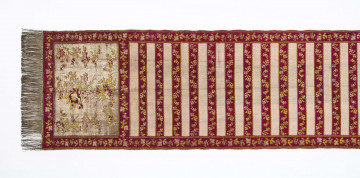
One-sided kontusz belt
1766 — 1788
National Museum in Lublin
Part of the collection: Textiles, embroideries, clothing and costume accessories of the 16th–19th c.
In the 18th century, numerous producers of robe (kontusz) belts, i.e., sash manufactories, were established in eastern Poland. Products from Stanisławów, Łohodów near Brodów, Nieśwież, and later Słuck, Różana, Korzec czy Buczacz were well known and valued. The factories had wealthy patrons, the owners of the surrounding estates. At the end of the 18th century, the high demand for belts led to the establishment of several weaving manufactories in Kraków. Those were small sash manufactories owned by the Kraków bourgeoisie and employed few weavers.
Among the owners of the seven Kraków workshops, Franciszek Masłowski was the most significant. In 1787, due to his efforts, he obtained from King Stanislaus August Poniatowski a privilege giving him the exclusive right to manufacture and sell his products in Kraków and the surroundings. Other weavers operating in the area worked illegally and were careful to sign their belts only with initials or their first name. On the other hand, Masłowski displayed his full name in his products, placing it in a frame. It was stamped in the corners of one of the heads, i.e., the decorative ends of the belt. The patterns of those belts were based on the most popular motifs found in Słuck belts or the Warsaw products of Paschalis Jakubowicz.
The belt from the National Museum in Lublin collection is an example of fabric with a head decoration in flowering rosettes in two medallions, undoubtedly inspired by the popular motifs of Słuck belts. It is a high-quality belt, four-sided and solid, with the addition of silver gilded thread. It belongs to the group of the most extended belts, measuring 460 cm. Masłowski made such fabrics until 1806. After that year, he changed his line of business and took up trading in wine as an invariably popular commodity. The portrait of Masłowski, preserved in the collection of the National Museum in Warsaw, was painted in 1810 after he had finished his weaver’s activities. It shows a confident man, dressed in Polish costume and proudly displaying a fancifully draped robe belt.
Magdalena Norkowska
Author / creator
Dimensions
cały obiekt: height: 460 cm, width: 37,5 cm
Object type
a contoured belt
Technique
weaving
Material
silk (natural fabric)
Creation time / dating
Creation / finding place
Owner
The National Museum in Lublin
Identification number
Location / status

1766 — 1788
National Museum in Lublin

1789 — 1793
National Museum in Lublin

1767 — 1780
National Museum in Lublin
DISCOVER this TOPIC
National Museum in Szczecin
DISCOVER this PATH
Educational path